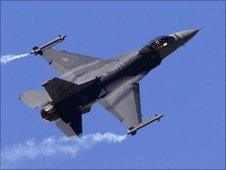Formula 1 engineers test fighter jet canopy
- Published
Formula 1 engineers have been testing out whether fighter jet canopies can be used on F1 cars to improve safety.
The FIA, the organisation in charge of world motor sport, carried out the experiment at its scientific institute.
F1 cars already go a long way to protect drivers from 200mph crashes, pile-ups and somersaults.
But these latest tests are specifically designed to find out if canopies would help protect them from debris on the track.
Two years ago Felipe Massa suffered a brain injury and fractured skull after being hit by a metal spring during qualifying for the Hungarian Grand Prix.
The size of a person's fist, the spring had come loose from another driver's car and slammed into Massa's helmet at more than 125 miles per hour.
At the time team boss Ross Brawn said: "We need to digest what's happened and understand it properly.
"It is time to look at the whole thing and take a balanced approach.
"You can have covers or canopies but you have to be able to get at the driver and extract him if there is an accident."
F-16 fighter jet
That's exactly what these tests have been designed to find out.
Andy Mellor is the FIA Institute's technical director.
"We have basically been looking into the science and engineering of protecting the cockpit from aggressive debris that can enter that space," he said.

A F-16 fighter jet performs at the 49th Paris Air Show in June 2011
So he and his team took to Bentwaters airfield near Ipswich with two tests in mind.
The first involved a polycarbonate windscreen, the second an F-16 fighter jet canopy made from areospace-spec polycarbonate.
Then a typical Formula 1 wheel and tyre, weighing 20kg, was fired into both at 140mph.
"It's an extremely precisely calibrated set-up," said Mr Mellor.
"Quite a lot of engineering has gone into it."
There were three firings for the two experiments, two at the windscreen and one at the canopy.
"The apparatus worked perfectly but visually it was possible to see that the windshield did manage to deflect the wheel over the space that would be occupied by the driver's helmet, but in so doing it sustained significant damage," he said.
It was a different story from the F-16 canopy though which survived the test intact and simply deflected the tyre away.
As for what happens with the results of these tests, Mr Mellor said: "This test was purely to look into the mechanical safety effect.
"Now that we have data on that, we can move towards a decision on what's next."
Follow our technology reporter Dan Whitworth on Twitter, external